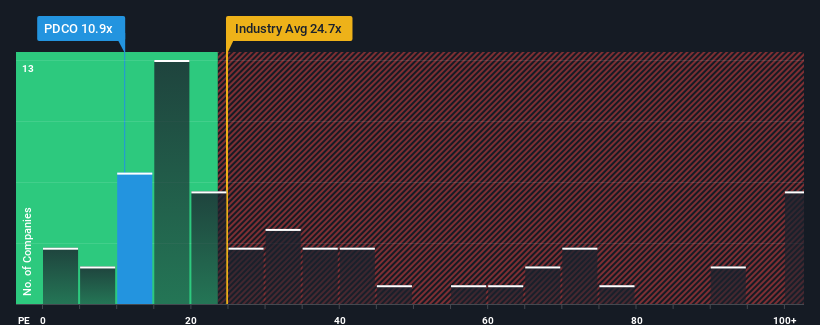- United States
- /
- Healthcare Services
- /
- NasdaqGS:PDCO
Investors Aren't Entirely Convinced By Patterson Companies, Inc.'s (NASDAQ:PDCO) Earnings

With a price-to-earnings (or "P/E") ratio of 10.9x Patterson Companies, Inc. (NASDAQ:PDCO) may be sending bullish signals at the moment, given that almost half of all companies in the United States have P/E ratios greater than 19x and even P/E's higher than 35x are not unusual. However, the P/E might be low for a reason and it requires further investigation to determine if it's justified.
Recent times haven't been advantageous for Patterson Companies as its earnings have been falling quicker than most other companies. The P/E is probably low because investors think this poor earnings performance isn't going to improve at all. If you still like the company, you'd want its earnings trajectory to turn around before making any decisions. Or at the very least, you'd be hoping the earnings slide doesn't get any worse if your plan is to pick up some stock while it's out of favour.
Check out our latest analysis for Patterson Companies

Does Growth Match The Low P/E?
The only time you'd be truly comfortable seeing a P/E as low as Patterson Companies' is when the company's growth is on track to lag the market.
Retrospectively, the last year delivered a frustrating 16% decrease to the company's bottom line. This has soured the latest three-year period, which nevertheless managed to deliver a decent 11% overall rise in EPS. Accordingly, while they would have preferred to keep the run going, shareholders would be roughly satisfied with the medium-term rates of earnings growth.
Turning to the outlook, the next three years should generate growth of 11% per annum as estimated by the nine analysts watching the company. That's shaping up to be similar to the 10% per year growth forecast for the broader market.
In light of this, it's peculiar that Patterson Companies' P/E sits below the majority of other companies. It may be that most investors are not convinced the company can achieve future growth expectations.
What We Can Learn From Patterson Companies' P/E?
Using the price-to-earnings ratio alone to determine if you should sell your stock isn't sensible, however it can be a practical guide to the company's future prospects.
We've established that Patterson Companies currently trades on a lower than expected P/E since its forecast growth is in line with the wider market. When we see an average earnings outlook with market-like growth, we assume potential risks are what might be placing pressure on the P/E ratio. It appears some are indeed anticipating earnings instability, because these conditions should normally provide more support to the share price.
Plus, you should also learn about these 3 warning signs we've spotted with Patterson Companies (including 2 which don't sit too well with us).
If P/E ratios interest you, you may wish to see this free collection of other companies with strong earnings growth and low P/E ratios.
New: Manage All Your Stock Portfolios in One Place
We've created the ultimate portfolio companion for stock investors, and it's free.
• Connect an unlimited number of Portfolios and see your total in one currency
• Be alerted to new Warning Signs or Risks via email or mobile
• Track the Fair Value of your stocks
Have feedback on this article? Concerned about the content? Get in touch with us directly. Alternatively, email editorial-team (at) simplywallst.com.
This article by Simply Wall St is general in nature. We provide commentary based on historical data and analyst forecasts only using an unbiased methodology and our articles are not intended to be financial advice. It does not constitute a recommendation to buy or sell any stock, and does not take account of your objectives, or your financial situation. We aim to bring you long-term focused analysis driven by fundamental data. Note that our analysis may not factor in the latest price-sensitive company announcements or qualitative material. Simply Wall St has no position in any stocks mentioned.
About NasdaqGS:PDCO
Patterson Companies
Engages in the distribution of dental and animal health products in the United States, the United Kingdom, and Canada.
Undervalued average dividend payer.
Similar Companies
Market Insights
Community Narratives




